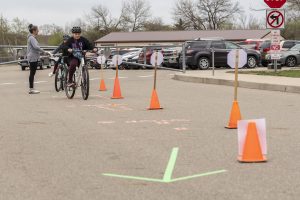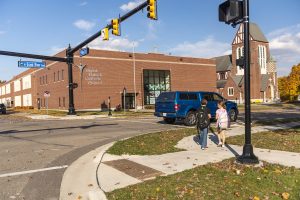
The quaint and picturesque mid-Michigan city of Portland is known as the “City of Two Rivers” as it is nestled between the Grand River and the Looking Glass River. It is home to nearly 4,000 residents with students that attend Portland Public Schools and St. Patrick Catholic School. While there are miles of multi-use trails, seven bridges, and numerous city parks throughout the town, commuting to the schools was difficult for students due to some precarious street crossings and sidewalks that were in need of improvement along the routes.
“We had a very dangerous intersection – where people don’t always look out for pedestrians. Tragically, one person was killed and another injured in a pedestrian crossing accident a few years ago…” said St. Patrick Catholic School Deacon and High School Principal Randy Hodge. “We’ve also had a problem where we’ve had so many kids crossing [at the intersection] that people waiting to turn left would back up all the way down past the next block.” said Hodge.
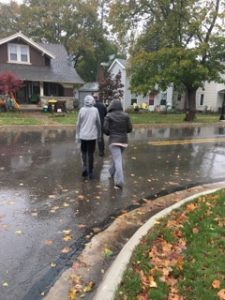
With issues compounding at the intersection, Hodge was spurred to investigate safety improvements so that students could walk, bike, and roll safely to and from school. Hodge researched and identified Michigan Fitness Foundation’s Safe Routes to School (SRTS) program as one that could help provide the largest impact in the community. He then reached out to the city of Portland and Portland Public Schools to build a local leadership committee to pursue a multi-district and city-wide SRTS major grant.
The City and Portland Public Schools joined the effort because there were “specific streets that were less safe for kids to walk or bike to school” according to Portland Public Schools Superintendent William Health.
With the core team formed, they started working with SRTS program staff to inform a planning process to improve walking and rolling routes for all students at both school districts. During the SRTS planning process, Heath led community members on walking audits which gave residents a firsthand understanding about the need for improvement along the routes that students used on their school commute. The walking audits also provided community engagement opportunities and a platform for the community to provide input by offering suggestions and lifting up concerns which were incorporated into the project.
“One of the biggest challenges regarding sidewalks was that not everyone wants a sidewalk in their yard and decisions needed to be made about keeping or removing trees,” shared Heath. “As a result of this feedback, the city worked with property owners regarding sidewalk placement and retained trees wherever possible.”
After gaining community support, the City improved sidewalk connectivity and updated infrastructure including the intersection signal upgrade with pedestrian buttons and timing revision, new sidewalk replacement and gap infill as needed for over two miles of sidewalk, more noticeable crossing improvements, traffic calming, as well as updated lighting along major feeder streets near the schools.
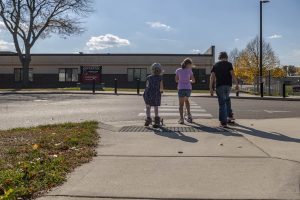

Through the efforts of many and with SRTS major grant funding, significant safety improvements were made which also motivated more students to be physically active and walk to school.
For example, where parents picked up and dropped off students were previously congested because most parents transported their kids to school in their vehicles. By creating a new remote drop off, traffic around the school has been reduced, and students are more active by walking a couple blocks from the drop off point to school.
Heath reflected, “I see more and more parents walking their kids to school especially at the younger level which is cool.”
Hodge concurred, “I have noticed we do have a lot more kids walking to school nowadays.”
Portland’s collaborative SRTS project has resulted in safe walking, biking, and rolling routes to and from school. The new infrastructure and programming also offers students time to be more physically active, explore their community, and socialize with one another, which contributes to their readiness to learn once they arrive at school.
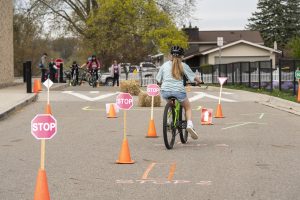
Project Impact
The City of Portland added walking, biking, and rolling infrastructure which will continue to positively impact students and residents citywide for decades to come. Portland Public Schools and St. Patrick Catholic School students have safer opportunities to get to and from school with improved transportation infrastructure. The significant sidewalk improvements, including new sidewalks where there previously were none, have motivated more students to be physically active and walk to school. The routes are also more accessible for all students who walk, bike, and roll to school because of the notable and noticeable infrastructure improvements.
MDOT Infrastructure Investment: $1,029,686
MDOT Non-infrastructure Investment: $39,993
This project was made possible through the continuing collaborative efforts of the City of Portland, Portland Public Schools, St. Patrick Catholic School, Michigan Fitness Foundation, Michigan Department of Transportation, and the Federal Highway Administration.

